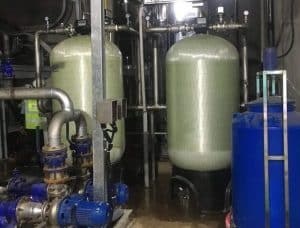Regeneration of ion exchange resins when the resins after a period of operation lose the ability to create an ion exchange reaction because the contaminant ions in the water have replaced all the ions on the exchange particle surface. Therefore, these resin beads need to be regenerated to remove contaminating ions and restore the ions present on the exchange beads.

Ion exchange resin beads treat Ca2+ Mg2+ hardness
Basic steps in the regeneration process of ion exchange resins
- Backwashing stage
Backwash the filter material to clean and remove suspended solids
The residues are sold on the ion exchange beads as well as the filter column walls, and the resin beads are redistributed.
At the end of the backwashing process, the water will be discharged.
- Regenerator injection stage
The regenerated solution from the tank will be pumped into the ion exchange column at a low speed.
This is the downstream washing process, the regeneration solution will come into contact with the plastic beads and carry out the regeneration process.
At the end of the process, the water will be discharged.
- Regenerator washing stage
Water will be drawn into the exchange column and the regenerant washing process will be carried out at a slow speed so as not to damage the resin particles.
With ion exchange systems using amphoteric exchange beads, this process will take place when each type of regeneration solution has been injected into the system.
Water after this process is discharged through the wastewater discharge line.
- The stage of returning water to the regeneration tank
Water is pumped into the filter column and the washing cycle continues until it reaches the target quality and is then pushed back to the regeneration tank.

Nam Viet ion exchange water softening system installed in the boiler of Heineken Vung Tau Brewery
Classification of ion exchange resin regeneration process
In ion exchange systems, one or more types of exchange resins are often used.
When the system operates, water will be introduced, run through the ion exchange column and perform the exchange reaction.
Depending on the path of the regeneration solution, it is divided into two types:
- Method of regeneration with flow
With this method, the exchange contact process and regeneration process go in one direction from top to bottom of the exchange column.
This method should not be used when strong flow is required or high treatment quality is required.
Strong acid cations or strong base anions require uniform regeneration; if they are not completely regenerated, the exchange resins can leak impurity ions into the water during treatment.
This is the disadvantage of the same-flow regeneration method
- Counterflow regeneration method
In this method, the contact and regeneration processes are upstream of each other.
The flow of the regeneration solution will be opposite to the flow of the contact process.
Because of the reverse flow, the regeneration solution will come into contact with the plastic layers and regenerate them more thoroughly, with less leakage of contaminants, the treated water has higher purity, and the amount of regenerant used. less than.
However, this method is truly effective when the resin layer is kept in place throughout the exchange process.
Substances used in the regeneration of ion exchange resins
In the previous article, you learned that there are 3 different types of ion exchange resins, so they require different regenerators.
- Strong acid cation granule regenerator
Strong acid cation exchange resins are often regenerated by:
– Sodium chloride NaCl: is the most common regenerant in water softener ion exchange systems because it is cheap and readily available
– Potassium chloride KCl is a common substitute for NaCl when the presence of Na in the post-softening water is not desired
– Ammonium chloride NH4Cl is commonly used in condenser heating applications
– Hydrochloric acid HCl is an effective regenerant and widely used in separation applications.
– Sulfuric acid H2SO4 is an alternative to HCl, less expensive, less dangerous but less reactive
- Weak acid cation granule regenerator
Some regenerative substances can be named as:
– Acid HCl
– Acid H2SO4 at low concentrations
– Acetic acid CH3COOH
– Citric acid C6H8O7
- Strong base anion resin regeneration agent
Strong base anion exchange resins are often regenerated using NaOH, which is always the substance of choice for use in demineralization applications.
- Weak base anion resin regeneration agent
– NaOH
– NH3
– Na2CO3
– Lime solutions
Regenerating softening system ion exchange with NaCl salt solution, refer to the video below below


Bài viết liên quan
Drinking water treatment for pigs and issues to note
Drinking water for pigs in particular and water treatment in livestock farming in general is...
Pure RO bottled water filtration system
What is a bottled water filtration system? The bottled water filtration system is essentially an...
Commonly applied water disinfection methods
Water disinfection is a mandatory step in the drinking and drinking process. Natural water contains...